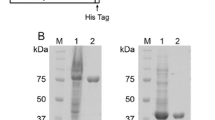Abstract
Bacillus thuringiensis subsp. kurstaki BUPM255 secretes a chitobiosidase Chi255 having an expected molecular weight of 70.665 kDa. When the corresponding gene, chi255, was expressed in E. coli, the active form, extracted from the periplasmic fraction of E. coli/pBADchi255, was of about 54 kDa, which suggested that Chi255 was excessively degraded by the action of E. coli proteases. Therefore, in vitro progressive C-terminal Chi255 deleted derivatives were constructed in order to study their stability and their activity in E. coli. Interestingly, when the chitin binding domain (CBD) was deleted from Chi255, an active form (Chi2555Δ5) of expected size of about 60 kDa was extracted from the E. coli periplasmic fraction, without the observation of any proteolytic degradation. Compared to Chi255, Chi255Δ5 exhibited a higher chitinase activity on colloidal chitin. Both of the enzymes exhibit activities at broad pH and temperature ranges with maximal enzyme activities at pH 5 and pH 6 and at temperatures 50°C and 40°C, respectively for Chi255 and Chi255Δ5. Thus, it was concluded that the C-terminal deletion of Chi255 CBD might be a nice tool for avoiding the excessive chitinase degradation, observed in the native chitinase, and for improving its activity.





Similar content being viewed by others
Abbreviations
- B.:
-
Bacillus
- E.:
-
Escherichia
- CBD:
-
Chitin binding domain
References
Gooday, G. W. (1990). The ecology of chitin decomposition. Advances in Microbial Ecology, 11, 378–430.
Henrissat, B. (1999). Classification of chitinases modules. EXS, 87, 137–156.
Henrissat, B., & Bairoch, A. (1993). New families in the classification of glycosyl hydrolases based on amino acid sequence similarities. The Biochemical Journal, 293, 781–788.
Jaoua, S., Zouari, N., Tounsi, S., & Ellouz, R. (1996). Study of particular delta-endotoxins produced by three recently isolated strains of Bacillus thuringiensis. FEMS Microbiology Letters, 145, 349–354.
Barboza-Corona, J. E., Contreras, J. C., Velazquez-Robledo, R., Bautista-Justo, M., Gomez-Ramirez, M., Cruz-Camarrillo, R., & Ibarra, J. E. (1999). Selection of chitinolytic strains of Bacillus thuringiensis. Biotechnology Letters, 21, 1125–1129.
Sampson, M. N., & Gooday, G. W. (1998). Involvement of chitinases of Bacillus thuringiensis during pathogenesis in insects. Microbiology, 144, 2189–2194.
Wiwat, C., Thaithanun, S., Pantuwatana, S., & Bhumiratana, A. (2000). Toxicity of chitinase-producing Bacillus thuringiensis sp. kurstaki HD-1 toward Plutella xylostella. Journal of Invertebrate Pathology, 79, 270–277.
Thamthiankul, S., Suan-Ngay, S., Tantimavanich, S., & Panbangred, W. (2001). Chitinase from Bacillus thuringiensis subsp. pakistani. Applied Microbiology and Biotechnology, 56, 395–401.
Liu, M., Cai, Q. X., Liu, H. Z., Zhang, B. H., Yan, J. P., & Yuan, Z. M. (2002). Chitinolytic activities in Bacillus thuringiensis and their synergistic effects on larvicidal activity. Journal of Applied Microbiology, 93, 374–379.
Lin, Y., & Xiong, G. (2004). Molecular cloning and sequence analysis of the chitinase gene from Bacillus thuringiensis serovar alesti. Biotechnology Letters, 26, 635–639.
Sneh, B., Schuster, S., & Gross, S. (1983). Improvement of the insecticidal activity of Bacillus thuringiensis var. entomocidus on larvae of Spodoptera littoralis (Lepidoptera–Noctuidae) by addition of chitinolytic bacteria, a phagostimulant and a UV-protectant. Zeitschrift Fur Angewandte Entomologie, 96, 77–83.
Regev, A., Keller, M., Strizhov, N., Sheh, B., Prudovsky, E., Chet, I., Ginzberg, I., Koncz-Kalman, Z., Koncz, C., Shnell, J., & Zilberstein, A. (1996). Synergistic activity of a Bacillus thuringiensis δ-endotoxin and a bacterial endochitinase against Spodoptera littoralis larvae. Applied and Environmental Microbiology, 62, 3581–3586.
Mabuchi, N., Hashizume, I., & Araki, Y. (2000). Characterization of chitinases excreted by Bacillus cereus CH. Canadian Journal of Microbiology, 46, 370–375.
Tantimavanich, S., Pantuwatana, S., Bhumiratana, A., & Panbangred, W. (1998). Multiple chitinase enzymes from a single gene of Bacillus licheniformis TP-1. Journal of Fermentation and Bioengineering, 85, 259–265.
Watanabe, T., Oyanagi, W., Suzuki, K., & Tanaka, H. (1990). Chitinase system of Bacillus circulans WL-12 and importance of chitinase A1 in chitin degradation. Journal of Bacteriology, 172, 4017–4022.
Driss, F., Kallassy-Awad, M., Zouari, N., & Jaoua, S. (2005). Molecular characterization of a novel chitinase from Bacillus thuringiensis subsp. kurstaki. Journal of Applied Microbiology, 99, 945–953.
Sambrook, J., Fritsch, E. F., & Maniatis, T. (1989). Molecular cloning. A laboratory manual, 2nd edn. Cold Spring Harbor, NY: Cold Spring Harbor Laboratory.
Manoil, C., & Beckwith, J. (1986). A genetic approach to analysing membrane protein topology. Science, 233, 1403–1408.
Miller, G. L. (1959). Use of dinitrosalicylic acid reagent for determination of reducing sugars. Analytical Chemistry, 31, 426–428.
Bradford, M. M. (1976). A rapid and sensitive method for the quantitation of microgram quantities of proteins utilizing the principle of protein-dye binding. Analytical Biochemistry, 72, 248–254.
Barboza-Corona, J. E., Nieto-Mazzocco, E., Vela’zquez-Robledo, R., Salcedo-Harnandez, R., Bautista, M., Jime’nez, B., & Ibarra, J. E. (2003). Cloning, sequencing, and expression of the chitinase gene chiA74 from Bacillus thuringiensis. Applied and Environmental Microbiology, 69, 1023–1029.
Morimoto, K., Karita, S., Kimura, T., Sakka, K., & Ohmiya, K. (1997). Cloning, sequencing, and expression of the gene encoding Clostridium paraputrificum chitinase ChiB and analysis of the functions of novel cadherin-like domains and a chitin-binding domain. Journal of Bacteriology, 179, 7306–7314.
Kuranda, M. J., & Robbins, P. W. (1991). Chitinase is required for cell separation during growth of Saccharomyces serevisiae. The Journal of Biological Chemistry, 266, 19758–19767.
Watanabe, T., Ito, Y., Hachimoto, M., Sekine, S., & Tanaka, H. (1994). The role of the C-terminal domain and type III domains chitinase A-1 from Bacillus circulans WL-12 in chitin degradation. Journal of Bacteriology, 176, 4465–4472.
Whalon, M. E., & Wingerd, B. A. (2003). Bt: Mode of action and use. Archieves of Insect Biochemistry and Physiology, 54, 200–211.
Acknowledgments
This work was supported by grants from the Tunisian « Ministère de l’Enseignement Supérieur, de la Recherche Scientifique et de la Technologie (MESRST) » and from the Islamic Educational, Scientific and Cultural Organization (ISESCO).
Author information
Authors and Affiliations
Corresponding author
Rights and permissions
About this article
Cite this article
Driss, F., Baanannou, A., Rouis, S. et al. Effect of the chitin binding domain deletion from Bacillus thuringiensis subsp. kurstaki chitinase Chi255 on its stability in Escherichia coli . Mol Biotechnol 36, 232–237 (2007). https://doi.org/10.1007/s12033-007-0030-4
Published:
Issue Date:
DOI: https://doi.org/10.1007/s12033-007-0030-4




